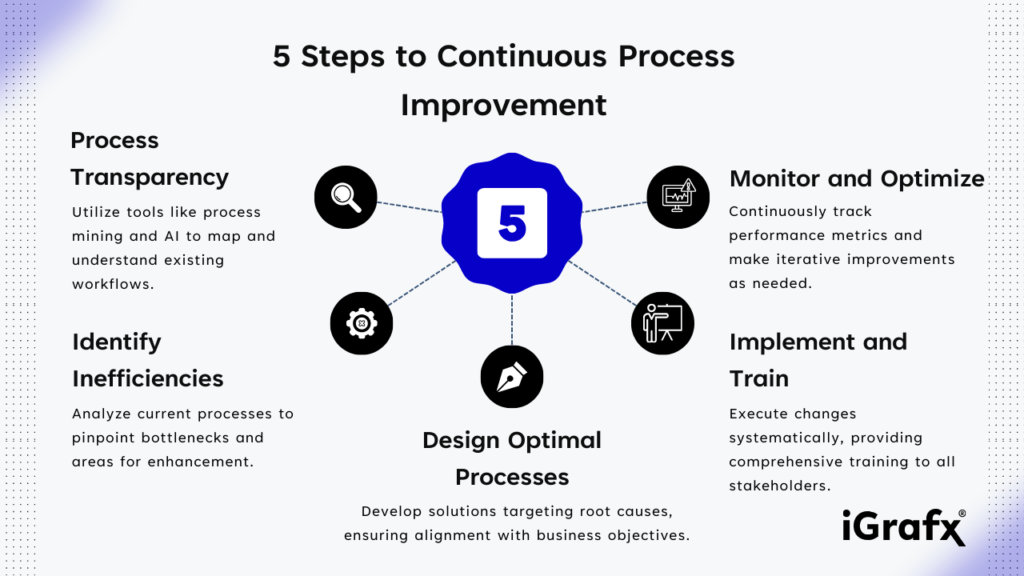The hardest thing about running a business isn’t coming up with good ideas – it’s making them happen. Every company has processes that are supposed to turn ideas into reality. But most of these processes don’t work as well as they should.
This gap between how things should work and how they actually work costs businesses about 20-30% of their revenue each year – a staggering figure highlighting why process improvement is beyond important, it is essential.
This article explores the concept of business process improvement, its significance, methodologies, and real-world applications, providing actionable insights for businesses aiming to achieve operational excellence.
Process Improvement: Making Business Work Better
Process improvement, sometimes called Business Process Improvement (BPI) or Continuous Improvement Process (CIP), is a systematic approach to analyzing, refining, and optimizing workflows within an organization. It identifies inefficiencies, eliminates bottlenecks, and aligns business operations with strategic goals. At its core, process improvement aims to achieve higher efficiency, reduce costs, improve quality, and enhance customer satisfaction.
Unlike one-off initiatives, process improvement efforts are an ongoing practice. Continuous monitoring, adaptation, and innovation are required to ensure processes remain effective.
For example:
- Before Improvement: A company’s invoice processing involves manual data entry, leading to delayed payments and frequent human errors.
- After Improvement: By implementing robotic process automation (RPA), the company automates invoice validation and approvals, reducing processing time by 60% and eliminating errors.
The Business Impact of Process Improvement
Every organization operates through interconnected processes, from supply chain logistics to customer service operations across various business units. When these workflows are inefficient or misaligned with strategic business goals, the entire organization suffers. Studies reveal that inefficient processes cost businesses an estimated $1 trillion annually, emphasizing the importance of process optimization.
Here’s why continuous process improvement is crucial:
- Enhanced Efficiency: Streamlining workflows eliminates redundancies, enabling tasks to be completed faster and more accurately.
- Cost Reduction: By eliminating waste and optimizing resource utilization, businesses can significantly reduce operational costs and improve their bottom line.
- Improved Customer Satisfaction: Efficient business processes lead to better product quality and faster service delivery, directly impacting customer satisfaction and loyalty.
- Increased Employee Engagement: Empowering employees with efficient tools and workflows reduces their frustration and boosts morale.
- Scalability and Agility: Ensures processes can grow alongside the business.
- Staying Competitive: Companies that continuously improve their processes can adapt quickly to market changes, new technologies, and evolving customer needs, giving them a competitive edge.
Why Processes Often Fail
Processes usually start out making sense. Someone thinks carefully about the best way to do something and writes it down. But then reality intervenes. Maybe the business grows and what worked for 10 customers doesn’t work for 1000. Maybe new technology makes some steps unnecessary. Or maybe people find better ways to do things, but the official process never gets updated. This is why even smart companies can have business processes that waste time and money. It’s not that anyone designed them to be inefficient. They just evolved that way.
In addition to processes failing to be as efficient and effective as possible, sometimes Process Improvement initiatives or programs fail to achieve their potential.
Common Failure Patterns in Traditional Process Improvement
- Starting Too Big: Trying to fix everything at once, not prioritizing properly, overwhelming the organization, losing momentum early
- Having the Wrong Focus: Emphasizing tools over outcomes, getting lost in process improvement methodology, missing the business impact, forgetting customer value
- Poor Execution: Not involving key stakeholders, insufficient resources, weak project management, poor change management
- Lack of Sustainability: No follow-through, insufficient training, weak governance, no accountability
Core Methodologies in Process Improvement
To achieve effective continuous process improvement, organizations often rely on established, popular process improvement methodologies. These frameworks provide structured approaches to identifying inefficiencies and implementing solutions.
Lean Methodology
Lean process improvement techniques focus on eliminating waste. In business processes, waste isn’t just physical materials – it’s also wasted time, effort, and opportunities. A lean approach might ask: “Does this approval step actually add value, or is it just habit?”
- Seven Wastes: Overproduction, waiting, transporting, over-processing, inventory, motion, and defects. Some add an eighth waste: not effectively utilizing your people / resources.
- Key Technique: Value Stream Mapping, which visualizes every step in a process to identify and remove non-value-adding activities, and produce to the demand of the customer.
- Core Impact: Streamlined processes that deliver maximum value with minimum waste.
Six Sigma Methodology
A data-driven methodology aiming to enhance customer satisfaction by delivering high-quality products and services with minimal defects. This is accomplished by reducing defects and variability in processes, using statistical tools and techniques.
- Key Technique: Statistical process control, Root-cause analysis tools, DMAIC (Define, Measure, Analyze, Improve, Control) framework for existing business processes and DMADV (Define, Measure, Analyze, Design, Verify) framework for new processes.
- Core Focus: Achieving 99.99967% quality in all business processes (or 3.4 defects per million opportunities).
Kaizen Methodology
A Japanese philosophy of continuous improvement through small, manageable changes involving all employees. Often part of an organizations’ Lean or Lean Six Sigma methodology.
- Key Technique: Regular feedback loops and small-scale adjustments to workflows.
- Core Principle: Improvement is everyone’s responsibility, from leadership to front-line employees.
Total Quality Management (TQM)
TQM integrates quality improvement into every aspect of business operations. It’s not just about having a quality control department – it’s about making quality everyone’s responsibility and building it into every process and decision.
- Key Principle: Customer-focused, total employee involvement, process-centered, integrated system.
- Core Impact: Creating an organization where quality drives every decision and action.
Theory of Constraints (ToC)
ToC focuses on identifying and addressing the most significant limiting factor (constraint) in a process. It recognizes that any process is only as strong as its weakest link and improving that constraint will have the greatest impact on overall performance.
- Key Steps: Identify constraint, exploit constraint, subordinate other processes, elevate constraint.
- Main Impact: Strategic focus on improvements that deliver the most significant system-wide benefits.
PDCA Cycle (Plan-Do-Check-Act)
An iterative four-step method (Plan-Do-Check-Act, or sometimes Plan-Do-Study-Adjust) used for controlling and improving business processes and products. Often part of a Lean Six Sigma methodology.
Plan: Identify an opportunity and plan for change.
Do: Implement the change on a small scale.
Check: Use data to analyze results.
Act: If successful, implement on a wider scale.
- Key Steps: Careful planning, small-scale testing, results verification, and broader implementation.
- Real Value: Reduces risk while ensuring improvements work before full deployment.
Steps to Continuous Process Improvement
Here’s what works when developing and implementing a process improvement strategy:
Getting Started: Process Transparency
You can’t fix what you don’t understand, and companies often don’t have the necessary transparency into processes or an effective way to understand where bottlenecks or delays exist. Process improvement starts with discovering and documenting your existing processes.
There are a few key ways to do this that don’t rely on interviewing countless stakeholders for their perception of the process:
Process Mining: Process mining provides transparency by using the data within existing IT systems to visually map workflows, uncovering inefficiencies, and highlighting deviations from intended processes. It offers a clear understanding of how processes are executed in real-world conditions, enabling data-driven improvements and optimized performance.
Artificial Intelligence (AI): Leverage a Process Intelligence Assistant, like Pia from iGrafx, to automatically create process diagrams from standard operating procedure (SOP) documents and natural language conversations. No matter the technical background, employees can use AI to instantly create accurate process models, ready for analysis and improvement.
Analyze Current Processes: Identify Inefficiencies
During this stage, organizations should gather comprehensive data about process performance, analyzing current metrics to identify bottlenecks and inefficiencies. This analysis should include a review of resource utilization and an assessment of compliance requirements that might affect process design.
To effectively analyze processes, start by using process mapping to map out each workflow in detail, from start to finish, to gain a clear understanding of how tasks are performed. This allows you to pinpoint where delays, redundancies, or manual interventions may be occurring. Utilizing process modeling tools like iGrafx enables you to visualize workflows, gather data, and identify inefficiencies with greater precision. Engage employees who are directly involved in the processes, as they often have valuable insights into pain points and opportunities for potential improvements.
Once the bottlenecks or other issues are identified, prioritize them based on their impact on performance and take targeted action, whether through automation, resource allocation, or redesigning the workflow.
A reminder that continuous monitoring and iterative improvements throughout the process will ensure that your processes remain efficient, effective, and adaptable to evolving business needs.
Design Optimal Processes: Achieving Process Excellence
With your analysis complete, you can start designing solutions that address root causes, not just symptoms. This phase requires careful thought about how changes will affect not just the process, but everyone who touches it. Involve employees, managers, and customers in the redesign process to ensure new workflows meet their needs and address pain points.
Success at this stage depends on setting clear objectives and developing detailed implementation plans and timelines. Think through resource requirements, ongoing training needs, and potential risks. Make sure your business process improvement plans align with broader business objectives and include specific metrics for measuring success.
Implementation and Training
Even the best-designed improvements can fail without proper implementation. Start by testing changes in controlled environments where you can identify and fix problems without disrupting the entire organization. Roll out changes systematically, ensuring proper employee training and support at each step.
Regular monitoring during initial implementation helps identify and address any immediate issues that arise. Be prepared to make quick adjustments and provide extra support where needed. Remember that resistance to change is natural – clear communication about why changes are happening and how they’ll help can make the transition smoother.
Monitoring and Optimization
Implementation isn’t the end – it’s just the beginning. Once new business processes are in place, maintain vigilant monitoring to ensure they’re delivering the expected results. This includes tracking performance metrics against objectives and implementing corrective actions when deviations occur. Regular review cycles help identify additional improvement opportunities and ensure processes remain effective as business conditions evolve.
Technology and Digital Transformation
Technology plays an increasingly crucial role in business process improvement. Some approaches include:
Process Mining
Solutions like Process Mining from iGrafx extract event log data to:
- Analyze actual workflows and bottlenecks
- Show conformance of the real process flows to the designed process
- Identify variations and inefficiencies
- Create detailed visual process maps
- Measure true performance metrics
Workflow Automation
Once you understand a process clearly, automation becomes a powerful tool for improvement. Strategic process automation helps:
- Eliminate manual, repetitive tasks
- Reduce human error in critical business processes
- Standardize key workflows
- Track performance consistently
- Enable scalable operations
- Improve compliance monitoring
- Free up employees for higher-value work
Simulation Tools
Testing new workflows digitally (using digital twins), before implementation, dramatically reduces risk and builds confidence in changes. These process simulation tools enable organizations to do the following, without impacting the current production processes:
- Model process changes accurately
- Predict likely outcomes
- Identify potential issues
- Optimize process design
- Validate expected benefits
Real-time Monitoring
Modern dashboards provide immediate visibility into process performance, enabling organizations to:
- Track Key Performance Indicators (KPIs) and other metrics in real-time
- Spot issues immediately
- Monitor compliance
- Make adjustments to process performance while they still matter
Predictive Analytics
AI-powered analytics help organizations stay ahead of potential problems:
- Warn you about likely bottlenecks or non-compliance to Service Level Agreements (SLAs) before they form
- Predict maintenance needs
- Anticipate resource requirements
- Identify emerging trends
- Enable proactive interventions
Overcoming Challenges in Process Improvement
Business process improvements face several significant challenges:
- People Don’t Like Change: Even when current processes are painful, people often prefer the problems they know to solutions they don’t.
- Complexity: Redesigning processes can be time-consuming and resource-intensive.
- Data Can Be Hard to Get: You can’t improve what you can’t measure, and sometimes getting good data is harder than it should be.
Strategies to Address Challenges
- Get People Involved Early: The people doing the work should help design the improvements. They know things you don’t.
- Start Small and Build: Big changes are risky. Start with improvements you can implement quickly and prove that the change worked.
- Use Advanced Tools: Platforms like iGrafx streamline process analysis and redesign, reducing complexity.
Real-World Example of Process Improvement: Schnellecke Logistics
The story of Schnellecke Logistics is a powerful demonstration of how iGrafx enables transformative changes for a globally integrated company by optimizing existing business processes. Schnellecke, a family-owned logistics leader with over 80 years of experience, faced the challenge of enhancing transparency, scalability, and efficiency in its existing processes across diverse departments and global locations. Their existing process management was inadequate for meeting these expansive needs.
To overcome these challenges, Schnellecke Logistics implemented iGrafx’s Process360 Live platform, which revolutionized their process management capabilities.
Challenges
- Lack of Visibility: Schnellecke struggled with limited visibility into key processes, which hindered a transparent understanding of company-wide operations.
- Scalability Issues: Their existing tools were unable to support global standardization and collaboration.
- Process Gaps: The company faced inefficiencies and risks due to unaddressed gaps in its operations.
Steps Taken
To overcome these challenges, Schnellecke Logistics implemented iGrafx’s Process360 Live platform in 2019, following a lean-inspired approach:
- Assessment and Strategy Formation:
- Identified inefficiencies in their existing tools and workflows.
- Established objectives for process improvement.
- Implementation of iGrafx Process360 Live:
- Migrated to a centralized platform for real-time business process management.
- Consolidated process instructions into a digital, accessible repository.
- Standardization and Digitization:
- Digitized over 18,600 documents and 2,800 process diagrams to create a unified framework, minimizing motion waste.
- Employee Training:
- Conducted workshops on lean methodology and robotic process automation (RPA) to equip employees with the necessary skills.
- Technology Integration:
- Introduced advanced tools like RPA, chatbots, and HR system interfaces.
- Ongoing Monitoring:
- Used real-time dashboards to track progress and make iterative improvements.
Results
- Global Accessibility: Schnellecke achieved centralized business process management, enabling real-time updates and fostering collaboration across locations.
- Transparency and Communication: Live dashboards and process maps provided unparalleled visibility into operations.
- Efficiency Gains: By identifying and addressing process gaps, Schnellecke minimized risks and enhanced operational efficiency.
- Compliance Excellence: Achieved stellar audit results by standardizing and digitizing processes.
This structured implementation of iGrafx aligned Schnellecke’s processes with lean principles, digitized workflows, and elevated global operations, making it a beacon for companies seeking comprehensive process improvement solutions.
The Path to Process Excellence
Remember: every business is built on processes. Making those processes work more effectively and efficiently is one of the most direct paths to better business performance.
The key to successful business process re-engineering is starting small but thinking big. Pick one process that’s clearly broken, map it out, gather data about how it’s performing, and make targeted improvements. Use the results from that first success to build momentum for bigger changes.
If you’re ready to start improving your business processes, iGrafx’s process intelligence platform can help you transform your operations and align them with your strategic goals. Our tools can help you discover, analyze, and optimize your processes in ways that create real business value.
Book a Demo today to learn how we can help you make your business processes work even better than they do now.


